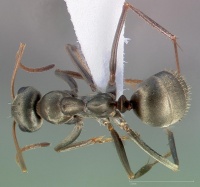Formica sibylla
| Formica sibylla | |
|---|---|

| |
| Scientific classification | |
| Kingdom: | Animalia |
| Phylum: | Arthropoda |
| Class: | Insecta |
| Order: | Hymenoptera |
| Family: | Formicidae |
| Subfamily: | Formicinae |
| Tribe: | Formicini |
| Genus: | Formica |
| Species: | F. sibylla |
| Binomial name | |
| Formica sibylla Wheeler, W.M., 1913 | |
Identification
Keys including this Species
- Key to Nearctic Formica fusca group males
- Key to Nearctic Formica fusca group queens
- Key to Nearctic Formica fusca group workers
Distribution
Oregon, California, and the Sierra Nevada in midwestern Nevada.
Latitudinal Distribution Pattern
Latitudinal Range: 44.03869° to 36.578275°.
| North Temperate |
North Subtropical |
Tropical | South Subtropical |
South Temperate |
- Source: AntMaps
Distribution based on Regional Taxon Lists
Nearctic Region: United States (type locality).
Distribution based on AntMaps
Distribution based on AntWeb specimens
Check data from AntWeb
Countries Occupied
| Number of countries occupied by this species based on AntWiki Regional Taxon Lists. In general, fewer countries occupied indicates a narrower range, while more countries indicates a more widespread species. |

|
Estimated Abundance
| Relative abundance based on number of AntMaps records per species (this species within the purple bar). Fewer records (to the left) indicates a less abundant/encountered species while more records (to the right) indicates more abundant/encountered species. |

|
Biology
Nevada, Wheeler and Wheeler (1986) - This montane species is restricted to the Carson Range of the Sierra Nevada near Lake Tahoe. Our 30 records are from 16 localities; 6,000-9,000 ft. All are in the Coniferous Forest Biome. This species constructed craters (Figs. 51, 52) in openings in the coniferous forest, where the soil was sandy and bare of vegetation. The dusty craters measured 15-28 cm in diameter and the rim was 2550 mm high: the entrance was large-19-38 mm. Frequently an enormous number of craters were clustered in a small area; we suspect that most were feeding stations, because we have never found brood upon excavation. We have found brood in only 2 nests both of which were under stones. The workers were very timid and fast.
Castes
Nomenclature
The following information is derived from Barry Bolton's Online Catalogue of the Ants of the World.
- sibylla. Formica sibylla Wheeler, W.M. 1913f: 530 (w.m.) U.S.A. See also: Wheeler, W.M. 1917a: 551; Francoeur, 1973: 263.
Unless otherwise noted the text for the remainder of this section is reported from the publication that includes the original description.
Description
References
- Borowiec, M.L., Cover, S.P., Rabeling, C. 2021. The evolution of social parasitism in Formica ants revealed by a global phylogeny. Proceedings of the National Academy of Sciences 118, e2026029118 (doi:10.1073/pnas.2026029118).
- Francoeur, A. 1973. Révision taxonomique des espèces néarctiques du groupe fusca, genre Formica (Formicidae, Hymenoptera). Mém. Soc. Entomol. Qué. 3: 1-316
- Wheeler, G. C. and J. Wheeler. 1986. The ants of Nevada. Natural History Museum of Los Angeles County, Los Angeles.
- Wheeler, W. M. 1913i. A revision of the ants of the genus Formica (Linné) Mayr. Bulletin of the Museum of Comparative Zoology 53: 379-565 (page 530, worker, male described)
- Wheeler, W. M. 1917a. The mountain ants of western North America. Proc. Am. Acad. Arts Sci. 52: 457-569 (page 551, see also)
References based on Global Ant Biodiversity Informatics
- Francoeur. A. 1973. Revision taxonomique des especes nearctiques du group fusca, genre Formica. Memoires de la Societe Entomologique du Quebec 3: 1-316.
- La Rivers I. 1968. A first listing of the ants of Nevada. Biological Society of Nevada, Occasional Papers 17: 1-12.
- Mallis A. 1941. A list of the ants of California with notes on their habits and distribution. Bulletin of the Southern California Academy of Sciences 40: 61-100.
- Wheeler G. C., and J. Wheeler. 1986. The ants of Nevada. Los Angeles: Natural History Museum of Los Angeles County, vii + 138 pp.
- Wheeler W. M. 1913. A revision of the ants of the genus Formica (Linné) Mayr. Bulletin of the Museum of Comparative Zoology 53: 379-565.
- Wheeler W. M. 1917. The mountain ants of western North America. Proceedings of the American Academy of Arts and Sciences 52: 457-569.
- Wheeler, G.C. and J. Wheeler. 1978. Mountain ants of Nevada. Great Basin Naturalist 35(4):379-396


